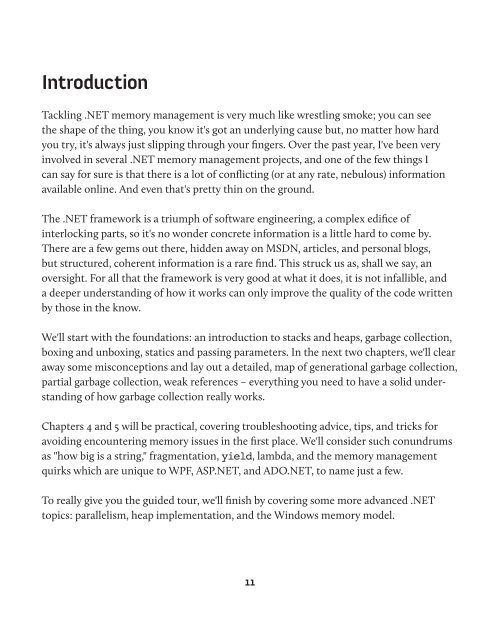Under the Hood of .NET Memory Management - Simple Talk
Under the Hood of .NET Memory Management - Simple Talk
Under the Hood of .NET Memory Management - Simple Talk
You also want an ePaper? Increase the reach of your titles
YUMPU automatically turns print PDFs into web optimized ePapers that Google loves.
Introduction<br />
Tackling .<strong>NET</strong> memory management is very much like wrestling smoke; you can see<br />
<strong>the</strong> shape <strong>of</strong> <strong>the</strong> thing, you know it's got an underlying cause but, no matter how hard<br />
you try, it's always just slipping through your fingers. Over <strong>the</strong> past year, I've been very<br />
involved in several .<strong>NET</strong> memory management projects, and one <strong>of</strong> <strong>the</strong> few things I<br />
can say for sure is that <strong>the</strong>re is a lot <strong>of</strong> conflicting (or at any rate, nebulous) information<br />
available online. And even that's pretty thin on <strong>the</strong> ground.<br />
The .<strong>NET</strong> framework is a triumph <strong>of</strong> s<strong>of</strong>tware engineering, a complex edifice <strong>of</strong><br />
interlocking parts, so it's no wonder concrete information is a little hard to come by.<br />
There are a few gems out <strong>the</strong>re, hidden away on MSDN, articles, and personal blogs,<br />
but structured, coherent information is a rare find. This struck us as, shall we say, an<br />
oversight. For all that <strong>the</strong> framework is very good at what it does, it is not infallible, and<br />
a deeper understanding <strong>of</strong> how it works can only improve <strong>the</strong> quality <strong>of</strong> <strong>the</strong> code written<br />
by those in <strong>the</strong> know.<br />
We'll start with <strong>the</strong> foundations: an introduction to stacks and heaps, garbage collection,<br />
boxing and unboxing, statics and passing parameters. In <strong>the</strong> next two chapters, we'll clear<br />
away some misconceptions and lay out a detailed, map <strong>of</strong> generational garbage collection,<br />
partial garbage collection, weak references – everything you need to have a solid understanding<br />
<strong>of</strong> how garbage collection really works.<br />
Chapters 4 and 5 will be practical, covering troubleshooting advice, tips, and tricks for<br />
avoiding encountering memory issues in <strong>the</strong> first place. We'll consider such conundrums<br />
as "how big is a string," fragmentation, yield, lambda, and <strong>the</strong> memory management<br />
quirks which are unique to WPF, ASP.<strong>NET</strong>, and ADO.<strong>NET</strong>, to name just a few.<br />
To really give you <strong>the</strong> guided tour, we'll finish by covering some more advanced .<strong>NET</strong><br />
topics: parallelism, heap implementation, and <strong>the</strong> Windows memory model.<br />
11











